Financial Statement Analysis of Crystal Hotels - Detailed Report
VerifiedAdded on 2023/06/08
|12
|1845
|79
Report
AI Summary
This report provides a financial analysis of Crystal Hotels, employing vertical analysis of both the income statement and balance sheet, alongside key financial ratio computations. The vertical analysis assesses various income statement items as a percentage of total revenue, revealing strengths in room service revenue and areas for improvement in cost of sales and unallocated expenses. Ratio analysis, including profitability, efficiency, and liquidity ratios, highlights the hotel's strong net profit margin and returns on assets and equity, but also identifies concerns with inventory turnover, account receivable periods, and liquidity positions relative to industry averages. The report concludes with recommendations for enhancing food and beverage services, reducing costs, improving debt policies, and balancing debt and equity capital sources to optimize the hotel's financial performance. Desklib offers a range of solved assignments and past papers to aid students in their studies.
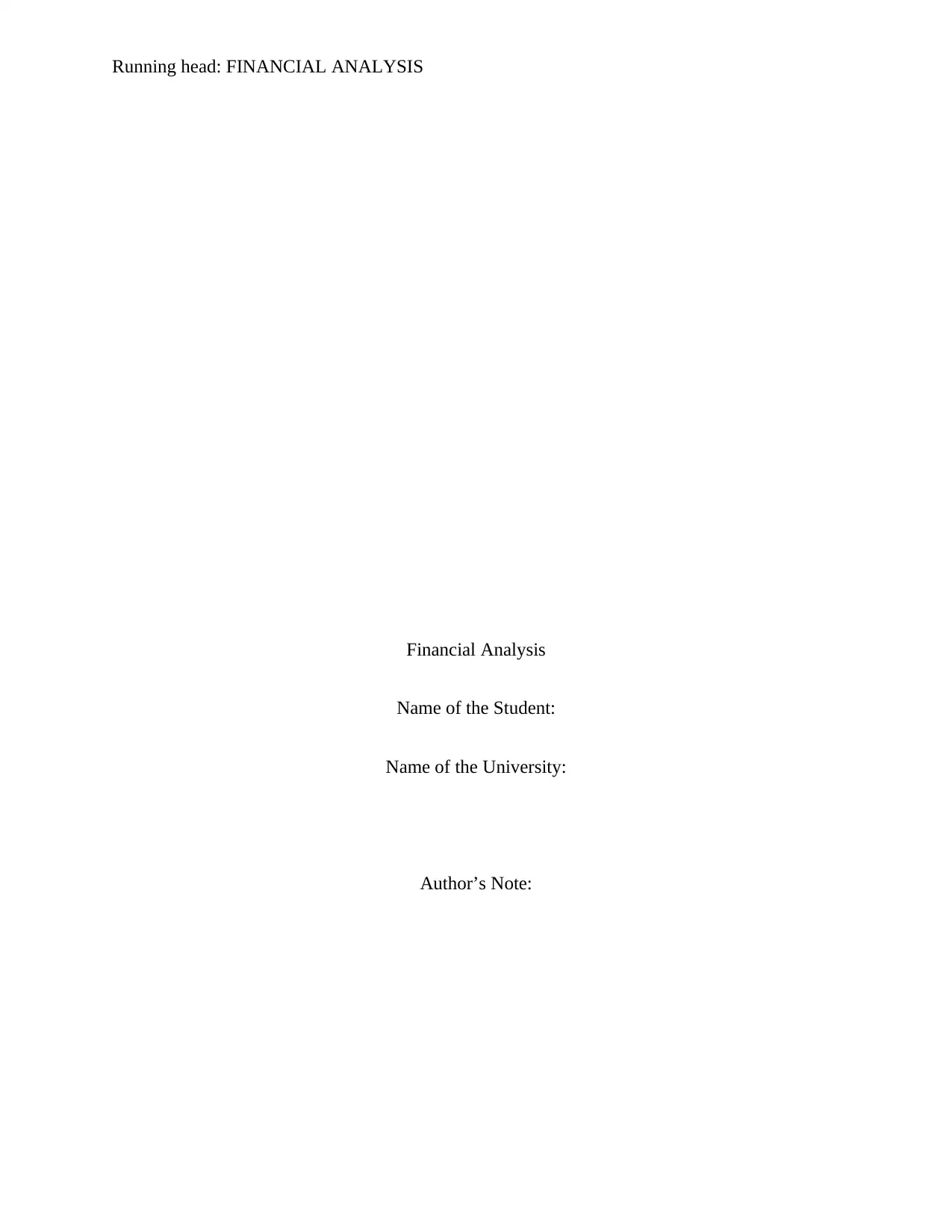
Running head: FINANCIAL ANALYSIS
Financial Analysis
Name of the Student:
Name of the University:
Author’s Note:
Financial Analysis
Name of the Student:
Name of the University:
Author’s Note:
Paraphrase This Document
Need a fresh take? Get an instant paraphrase of this document with our AI Paraphraser
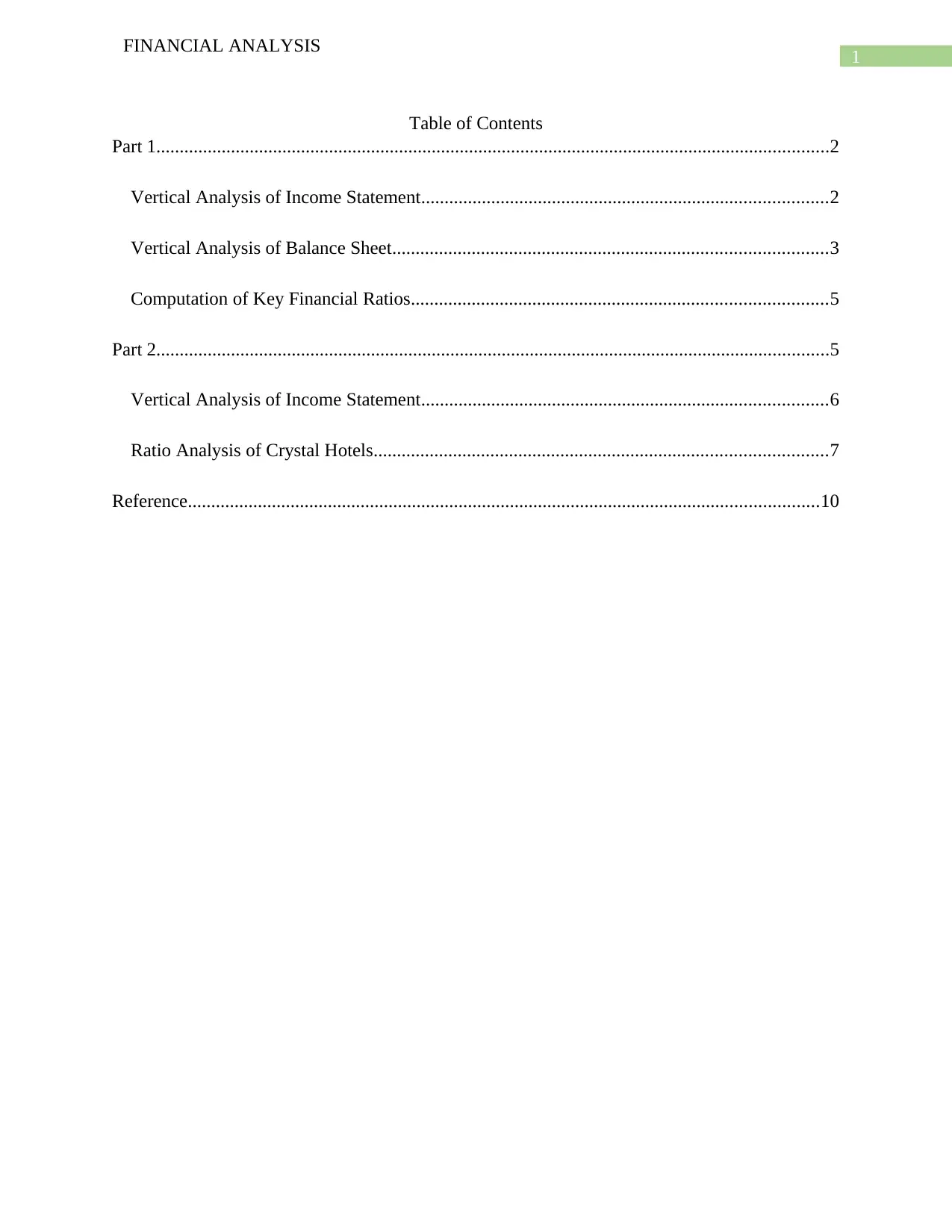
1
FINANCIAL ANALYSIS
Table of Contents
Part 1................................................................................................................................................2
Vertical Analysis of Income Statement.......................................................................................2
Vertical Analysis of Balance Sheet.............................................................................................3
Computation of Key Financial Ratios.........................................................................................5
Part 2................................................................................................................................................5
Vertical Analysis of Income Statement.......................................................................................6
Ratio Analysis of Crystal Hotels.................................................................................................7
Reference.......................................................................................................................................10
FINANCIAL ANALYSIS
Table of Contents
Part 1................................................................................................................................................2
Vertical Analysis of Income Statement.......................................................................................2
Vertical Analysis of Balance Sheet.............................................................................................3
Computation of Key Financial Ratios.........................................................................................5
Part 2................................................................................................................................................5
Vertical Analysis of Income Statement.......................................................................................6
Ratio Analysis of Crystal Hotels.................................................................................................7
Reference.......................................................................................................................................10
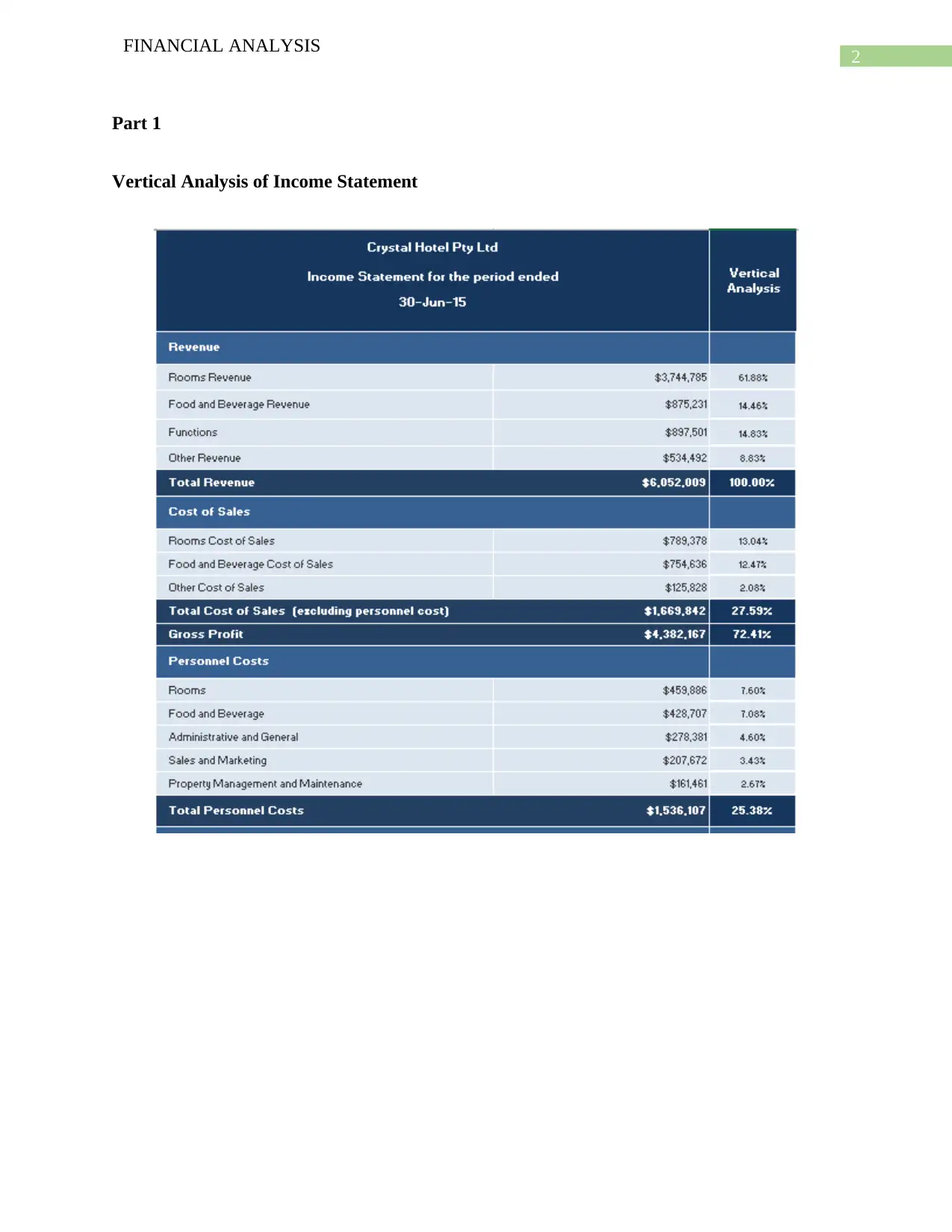
2
FINANCIAL ANALYSIS
Part 1
Vertical Analysis of Income Statement
FINANCIAL ANALYSIS
Part 1
Vertical Analysis of Income Statement
⊘ This is a preview!⊘
Do you want full access?
Subscribe today to unlock all pages.

Trusted by 1+ million students worldwide
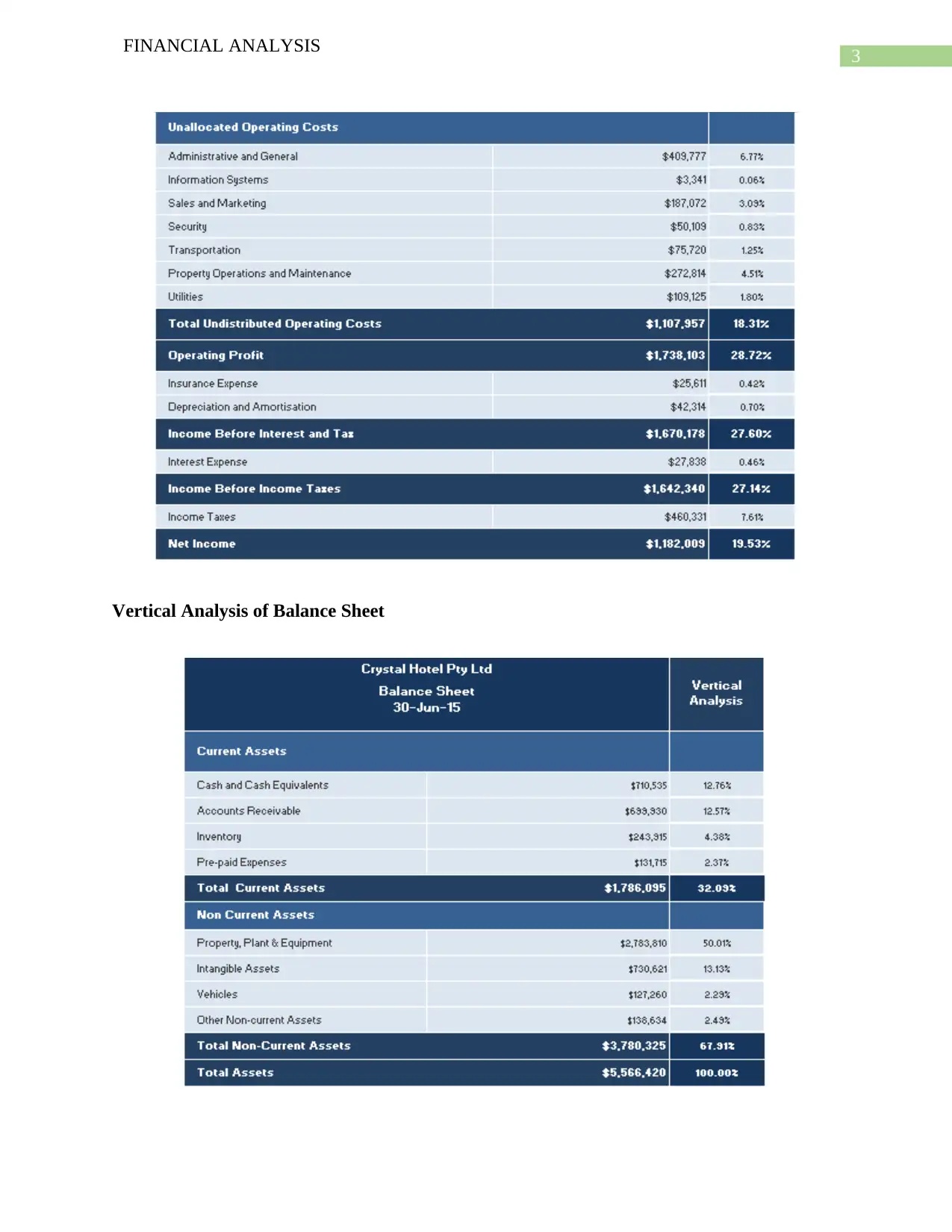
3
FINANCIAL ANALYSIS
Vertical Analysis of Balance Sheet
FINANCIAL ANALYSIS
Vertical Analysis of Balance Sheet
Paraphrase This Document
Need a fresh take? Get an instant paraphrase of this document with our AI Paraphraser
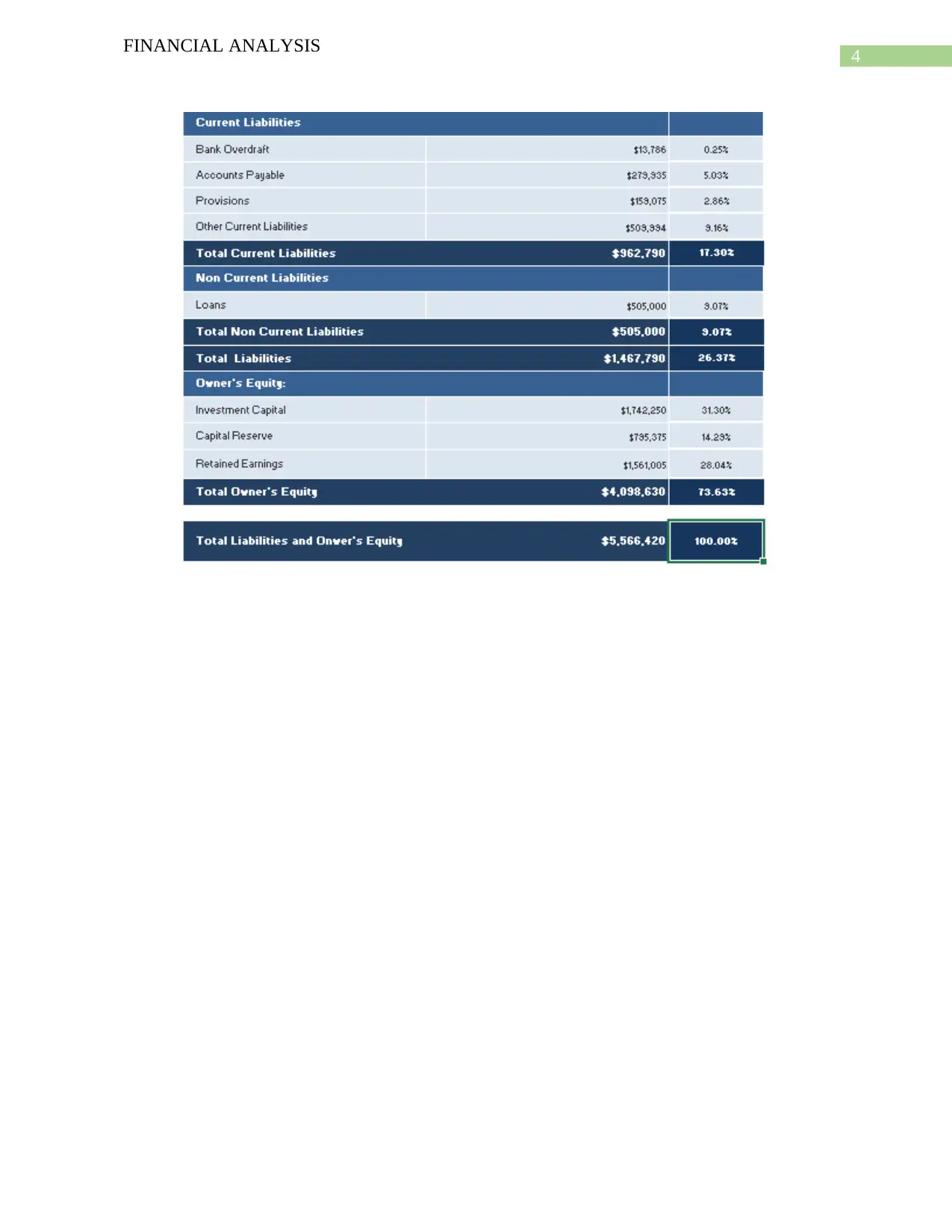
4
FINANCIAL ANALYSIS
FINANCIAL ANALYSIS
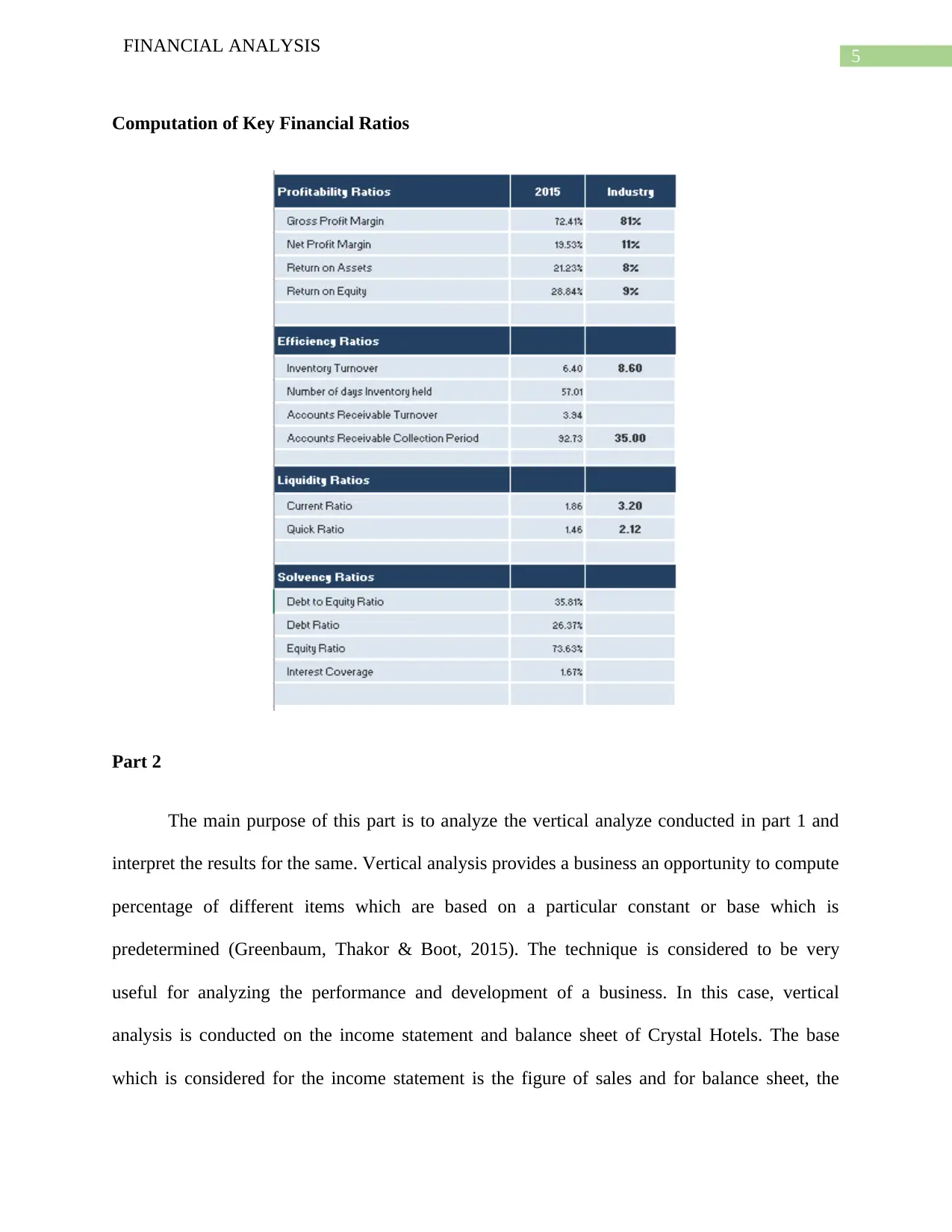
5
FINANCIAL ANALYSIS
Computation of Key Financial Ratios
Part 2
The main purpose of this part is to analyze the vertical analyze conducted in part 1 and
interpret the results for the same. Vertical analysis provides a business an opportunity to compute
percentage of different items which are based on a particular constant or base which is
predetermined (Greenbaum, Thakor & Boot, 2015). The technique is considered to be very
useful for analyzing the performance and development of a business. In this case, vertical
analysis is conducted on the income statement and balance sheet of Crystal Hotels. The base
which is considered for the income statement is the figure of sales and for balance sheet, the
FINANCIAL ANALYSIS
Computation of Key Financial Ratios
Part 2
The main purpose of this part is to analyze the vertical analyze conducted in part 1 and
interpret the results for the same. Vertical analysis provides a business an opportunity to compute
percentage of different items which are based on a particular constant or base which is
predetermined (Greenbaum, Thakor & Boot, 2015). The technique is considered to be very
useful for analyzing the performance and development of a business. In this case, vertical
analysis is conducted on the income statement and balance sheet of Crystal Hotels. The base
which is considered for the income statement is the figure of sales and for balance sheet, the
⊘ This is a preview!⊘
Do you want full access?
Subscribe today to unlock all pages.

Trusted by 1+ million students worldwide

6
FINANCIAL ANALYSIS
figures of total assets and total equity and liabilities are taken (Petty et al., 2015). The percentage
are then to be compared to industry averages in order to establish comparative analysis.
Vertical Analysis of Income Statement
The vertical analysis which is conducted on the income statement of Crystal Hotel
reveals that total revenue is taken as a constant for the purpose of computing percentages for
various items of the income statement. The total revenue which the business earns is significant
out of which revenue which the hotel earns from room service is enormous and forms a major
part of the total revenue earned by the business (Horngren & Harrison, 2015). The percentage is
shown to be 61.88% in case of Crystal Hotel while the industry average for the same appears to
be 57%. This is a favorable indicator which suggest that the room service of the hotel is better
than most of the hotels in the industry and therefore the room sales for the hotel is so much more.
The management of Crystal Hotels also earns a significant amount of revenue from food and
beverage services and functions and other incomes as well (Brusca et al., 2016). The cost of sales
of Crystal Hotel in terms of percentage is shown to be much more than industry average which
suggest that there is ample scope for improvements in this area. The cost of sales for the year
2015 is shown to be 27.59% which is more than the industry average. The personal costs of the
business reveal that the personal costs incurred for room expenses and food and beverages are
shown to be 7.60% and 7.08% for the year 2015. These estimates are lower than the industry
average of the business which is a positive sign and moreover, the total of the personal costs
which in percentage terms comes to 25.38% is also lower than the industry average. The total
unallocated expenses however of the industry which is shown to be 16% is lower than the
estimate for unallocated expenses for Crystal Hotel which is shown to be 18.31%. The
FINANCIAL ANALYSIS
figures of total assets and total equity and liabilities are taken (Petty et al., 2015). The percentage
are then to be compared to industry averages in order to establish comparative analysis.
Vertical Analysis of Income Statement
The vertical analysis which is conducted on the income statement of Crystal Hotel
reveals that total revenue is taken as a constant for the purpose of computing percentages for
various items of the income statement. The total revenue which the business earns is significant
out of which revenue which the hotel earns from room service is enormous and forms a major
part of the total revenue earned by the business (Horngren & Harrison, 2015). The percentage is
shown to be 61.88% in case of Crystal Hotel while the industry average for the same appears to
be 57%. This is a favorable indicator which suggest that the room service of the hotel is better
than most of the hotels in the industry and therefore the room sales for the hotel is so much more.
The management of Crystal Hotels also earns a significant amount of revenue from food and
beverage services and functions and other incomes as well (Brusca et al., 2016). The cost of sales
of Crystal Hotel in terms of percentage is shown to be much more than industry average which
suggest that there is ample scope for improvements in this area. The cost of sales for the year
2015 is shown to be 27.59% which is more than the industry average. The personal costs of the
business reveal that the personal costs incurred for room expenses and food and beverages are
shown to be 7.60% and 7.08% for the year 2015. These estimates are lower than the industry
average of the business which is a positive sign and moreover, the total of the personal costs
which in percentage terms comes to 25.38% is also lower than the industry average. The total
unallocated expenses however of the industry which is shown to be 16% is lower than the
estimate for unallocated expenses for Crystal Hotel which is shown to be 18.31%. The
Paraphrase This Document
Need a fresh take? Get an instant paraphrase of this document with our AI Paraphraser
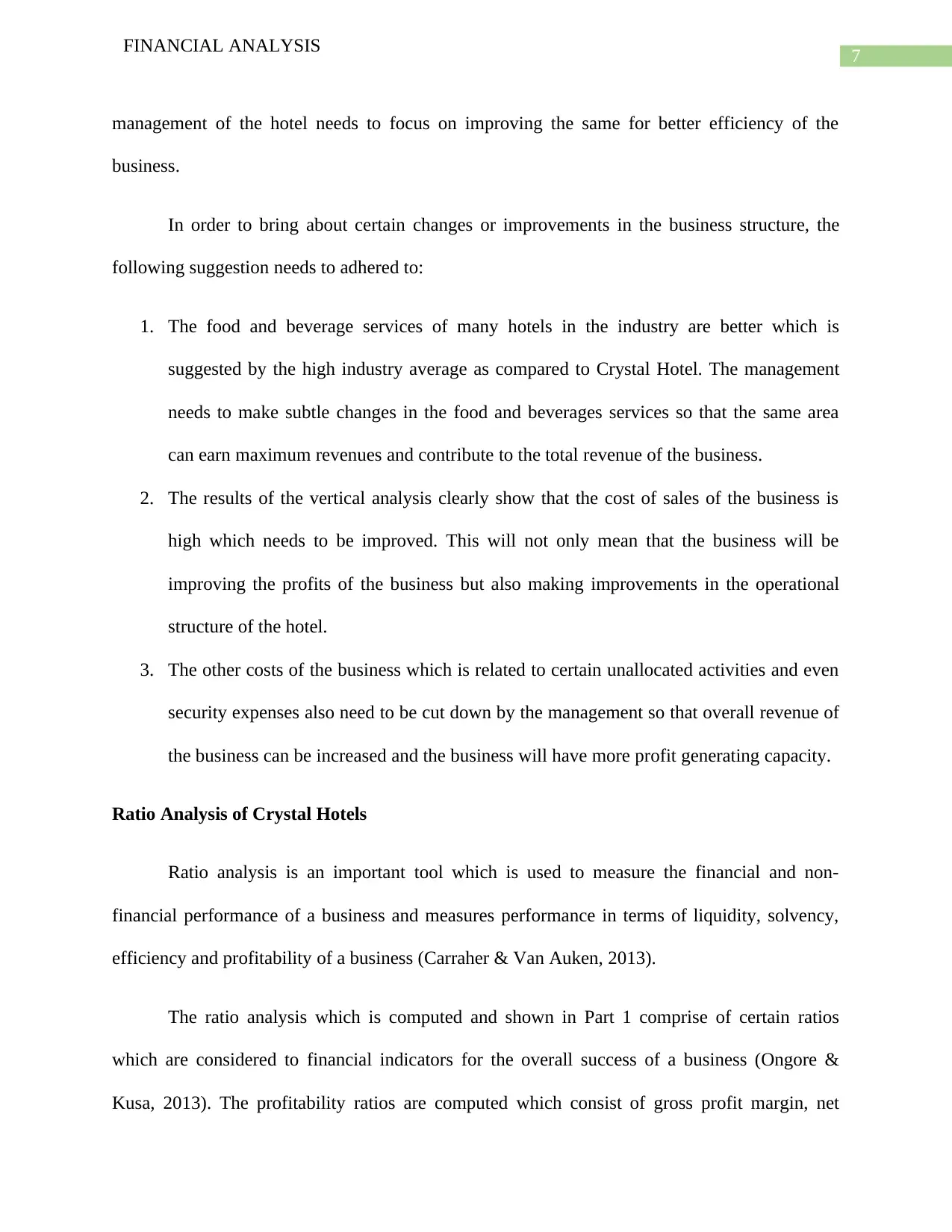
7
FINANCIAL ANALYSIS
management of the hotel needs to focus on improving the same for better efficiency of the
business.
In order to bring about certain changes or improvements in the business structure, the
following suggestion needs to adhered to:
1. The food and beverage services of many hotels in the industry are better which is
suggested by the high industry average as compared to Crystal Hotel. The management
needs to make subtle changes in the food and beverages services so that the same area
can earn maximum revenues and contribute to the total revenue of the business.
2. The results of the vertical analysis clearly show that the cost of sales of the business is
high which needs to be improved. This will not only mean that the business will be
improving the profits of the business but also making improvements in the operational
structure of the hotel.
3. The other costs of the business which is related to certain unallocated activities and even
security expenses also need to be cut down by the management so that overall revenue of
the business can be increased and the business will have more profit generating capacity.
Ratio Analysis of Crystal Hotels
Ratio analysis is an important tool which is used to measure the financial and non-
financial performance of a business and measures performance in terms of liquidity, solvency,
efficiency and profitability of a business (Carraher & Van Auken, 2013).
The ratio analysis which is computed and shown in Part 1 comprise of certain ratios
which are considered to financial indicators for the overall success of a business (Ongore &
Kusa, 2013). The profitability ratios are computed which consist of gross profit margin, net
FINANCIAL ANALYSIS
management of the hotel needs to focus on improving the same for better efficiency of the
business.
In order to bring about certain changes or improvements in the business structure, the
following suggestion needs to adhered to:
1. The food and beverage services of many hotels in the industry are better which is
suggested by the high industry average as compared to Crystal Hotel. The management
needs to make subtle changes in the food and beverages services so that the same area
can earn maximum revenues and contribute to the total revenue of the business.
2. The results of the vertical analysis clearly show that the cost of sales of the business is
high which needs to be improved. This will not only mean that the business will be
improving the profits of the business but also making improvements in the operational
structure of the hotel.
3. The other costs of the business which is related to certain unallocated activities and even
security expenses also need to be cut down by the management so that overall revenue of
the business can be increased and the business will have more profit generating capacity.
Ratio Analysis of Crystal Hotels
Ratio analysis is an important tool which is used to measure the financial and non-
financial performance of a business and measures performance in terms of liquidity, solvency,
efficiency and profitability of a business (Carraher & Van Auken, 2013).
The ratio analysis which is computed and shown in Part 1 comprise of certain ratios
which are considered to financial indicators for the overall success of a business (Ongore &
Kusa, 2013). The profitability ratios are computed which consist of gross profit margin, net
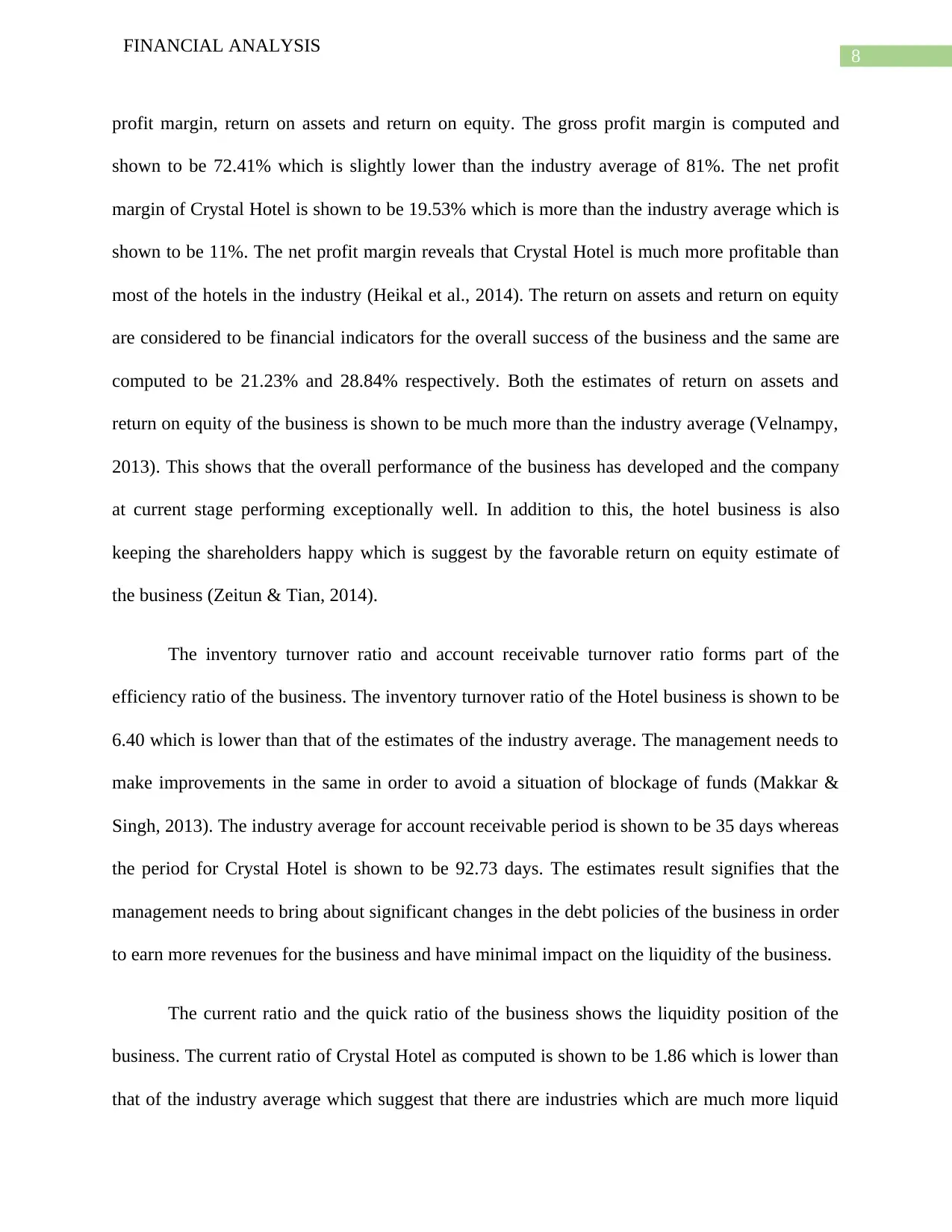
8
FINANCIAL ANALYSIS
profit margin, return on assets and return on equity. The gross profit margin is computed and
shown to be 72.41% which is slightly lower than the industry average of 81%. The net profit
margin of Crystal Hotel is shown to be 19.53% which is more than the industry average which is
shown to be 11%. The net profit margin reveals that Crystal Hotel is much more profitable than
most of the hotels in the industry (Heikal et al., 2014). The return on assets and return on equity
are considered to be financial indicators for the overall success of the business and the same are
computed to be 21.23% and 28.84% respectively. Both the estimates of return on assets and
return on equity of the business is shown to be much more than the industry average (Velnampy,
2013). This shows that the overall performance of the business has developed and the company
at current stage performing exceptionally well. In addition to this, the hotel business is also
keeping the shareholders happy which is suggest by the favorable return on equity estimate of
the business (Zeitun & Tian, 2014).
The inventory turnover ratio and account receivable turnover ratio forms part of the
efficiency ratio of the business. The inventory turnover ratio of the Hotel business is shown to be
6.40 which is lower than that of the estimates of the industry average. The management needs to
make improvements in the same in order to avoid a situation of blockage of funds (Makkar &
Singh, 2013). The industry average for account receivable period is shown to be 35 days whereas
the period for Crystal Hotel is shown to be 92.73 days. The estimates result signifies that the
management needs to bring about significant changes in the debt policies of the business in order
to earn more revenues for the business and have minimal impact on the liquidity of the business.
The current ratio and the quick ratio of the business shows the liquidity position of the
business. The current ratio of Crystal Hotel as computed is shown to be 1.86 which is lower than
that of the industry average which suggest that there are industries which are much more liquid
FINANCIAL ANALYSIS
profit margin, return on assets and return on equity. The gross profit margin is computed and
shown to be 72.41% which is slightly lower than the industry average of 81%. The net profit
margin of Crystal Hotel is shown to be 19.53% which is more than the industry average which is
shown to be 11%. The net profit margin reveals that Crystal Hotel is much more profitable than
most of the hotels in the industry (Heikal et al., 2014). The return on assets and return on equity
are considered to be financial indicators for the overall success of the business and the same are
computed to be 21.23% and 28.84% respectively. Both the estimates of return on assets and
return on equity of the business is shown to be much more than the industry average (Velnampy,
2013). This shows that the overall performance of the business has developed and the company
at current stage performing exceptionally well. In addition to this, the hotel business is also
keeping the shareholders happy which is suggest by the favorable return on equity estimate of
the business (Zeitun & Tian, 2014).
The inventory turnover ratio and account receivable turnover ratio forms part of the
efficiency ratio of the business. The inventory turnover ratio of the Hotel business is shown to be
6.40 which is lower than that of the estimates of the industry average. The management needs to
make improvements in the same in order to avoid a situation of blockage of funds (Makkar &
Singh, 2013). The industry average for account receivable period is shown to be 35 days whereas
the period for Crystal Hotel is shown to be 92.73 days. The estimates result signifies that the
management needs to bring about significant changes in the debt policies of the business in order
to earn more revenues for the business and have minimal impact on the liquidity of the business.
The current ratio and the quick ratio of the business shows the liquidity position of the
business. The current ratio of Crystal Hotel as computed is shown to be 1.86 which is lower than
that of the industry average which suggest that there are industries which are much more liquid
⊘ This is a preview!⊘
Do you want full access?
Subscribe today to unlock all pages.

Trusted by 1+ million students worldwide
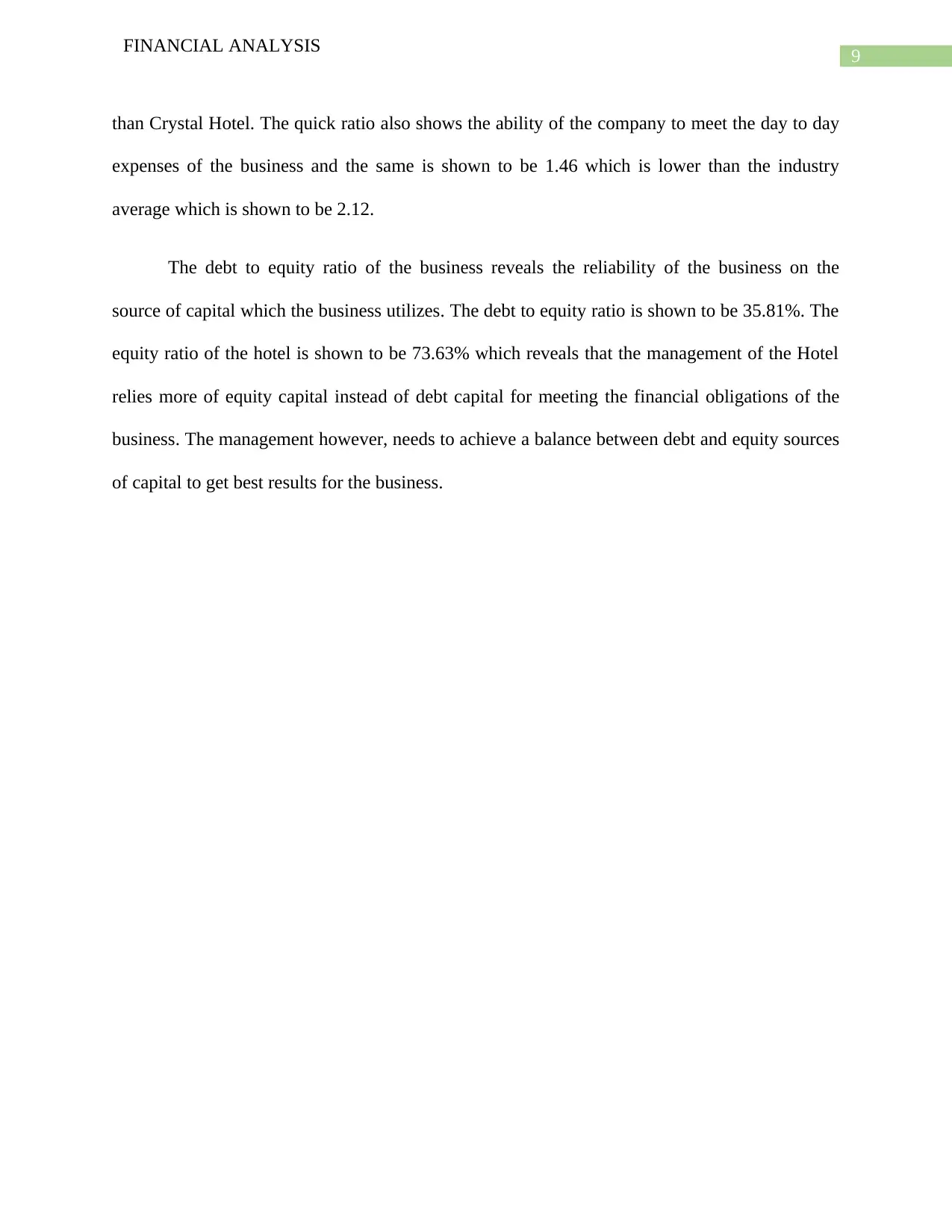
9
FINANCIAL ANALYSIS
than Crystal Hotel. The quick ratio also shows the ability of the company to meet the day to day
expenses of the business and the same is shown to be 1.46 which is lower than the industry
average which is shown to be 2.12.
The debt to equity ratio of the business reveals the reliability of the business on the
source of capital which the business utilizes. The debt to equity ratio is shown to be 35.81%. The
equity ratio of the hotel is shown to be 73.63% which reveals that the management of the Hotel
relies more of equity capital instead of debt capital for meeting the financial obligations of the
business. The management however, needs to achieve a balance between debt and equity sources
of capital to get best results for the business.
FINANCIAL ANALYSIS
than Crystal Hotel. The quick ratio also shows the ability of the company to meet the day to day
expenses of the business and the same is shown to be 1.46 which is lower than the industry
average which is shown to be 2.12.
The debt to equity ratio of the business reveals the reliability of the business on the
source of capital which the business utilizes. The debt to equity ratio is shown to be 35.81%. The
equity ratio of the hotel is shown to be 73.63% which reveals that the management of the Hotel
relies more of equity capital instead of debt capital for meeting the financial obligations of the
business. The management however, needs to achieve a balance between debt and equity sources
of capital to get best results for the business.
Paraphrase This Document
Need a fresh take? Get an instant paraphrase of this document with our AI Paraphraser

10
FINANCIAL ANALYSIS
Reference
Brusca, I., Caperchione, E., Cohen, S., & Rossi, F. M. (Eds.). (2016). Public sector accounting
and auditing in Europe: The challenge of harmonization. Springer.
Carraher, S., & Van Auken, H. (2013). The use of financial statements for decision making by
small firms. Journal of Small Business & Entrepreneurship, 26(3), 323-336.
Greenbaum, S. I., Thakor, A. V., & Boot, A. (Eds.). (2015). Contemporary financial
intermediation. Academic Press.
Heikal, M., Khaddafi, M., & Ummah, A. (2014). Influence analysis of return on assets (ROA),
return on equity (ROE), net profit margin (NPM), debt to equity ratio (DER), and current ratio
(CR), against corporate profit growth in automotive in Indonesia Stock
Exchange. International Journal of Academic Research in Business and Social
Sciences, 4(12), 101.
Horngren, C., & Harrison, W. (2015). ACCOUNTING: BSB110. Pearson Higher Education AU.
Makkar, A., & Singh, S. (2013). Analysis of the financial performance of Indian commercial
banks: A comparative study. Indian Journal of Finance, 7(5), 41-49.
Ongore, V. O., & Kusa, G. B. (2013). Determinants of financial performance of commercial
banks in Kenya. International Journal of Economics and Financial Issues, 3(1), 237-252.
FINANCIAL ANALYSIS
Reference
Brusca, I., Caperchione, E., Cohen, S., & Rossi, F. M. (Eds.). (2016). Public sector accounting
and auditing in Europe: The challenge of harmonization. Springer.
Carraher, S., & Van Auken, H. (2013). The use of financial statements for decision making by
small firms. Journal of Small Business & Entrepreneurship, 26(3), 323-336.
Greenbaum, S. I., Thakor, A. V., & Boot, A. (Eds.). (2015). Contemporary financial
intermediation. Academic Press.
Heikal, M., Khaddafi, M., & Ummah, A. (2014). Influence analysis of return on assets (ROA),
return on equity (ROE), net profit margin (NPM), debt to equity ratio (DER), and current ratio
(CR), against corporate profit growth in automotive in Indonesia Stock
Exchange. International Journal of Academic Research in Business and Social
Sciences, 4(12), 101.
Horngren, C., & Harrison, W. (2015). ACCOUNTING: BSB110. Pearson Higher Education AU.
Makkar, A., & Singh, S. (2013). Analysis of the financial performance of Indian commercial
banks: A comparative study. Indian Journal of Finance, 7(5), 41-49.
Ongore, V. O., & Kusa, G. B. (2013). Determinants of financial performance of commercial
banks in Kenya. International Journal of Economics and Financial Issues, 3(1), 237-252.
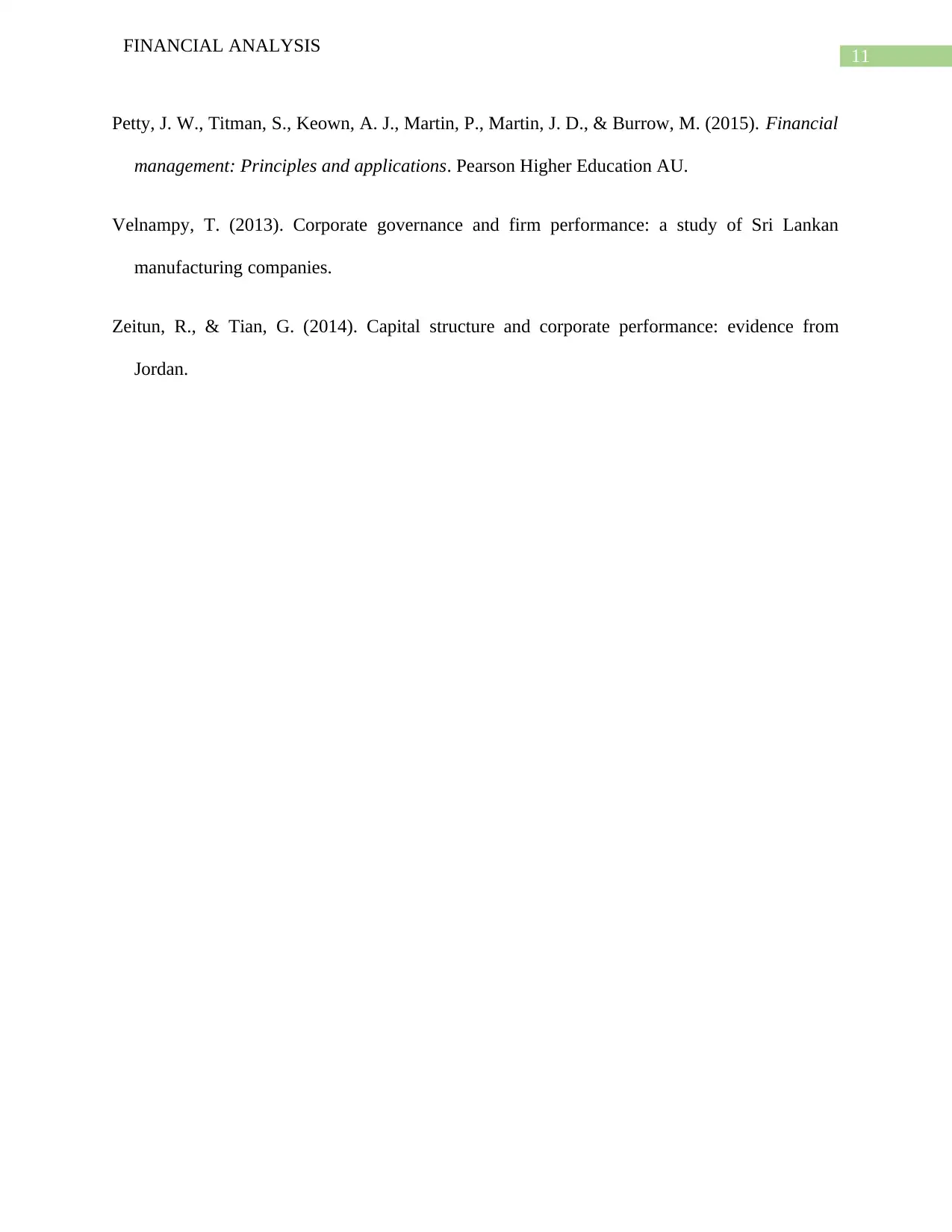
11
FINANCIAL ANALYSIS
Petty, J. W., Titman, S., Keown, A. J., Martin, P., Martin, J. D., & Burrow, M. (2015). Financial
management: Principles and applications. Pearson Higher Education AU.
Velnampy, T. (2013). Corporate governance and firm performance: a study of Sri Lankan
manufacturing companies.
Zeitun, R., & Tian, G. (2014). Capital structure and corporate performance: evidence from
Jordan.
FINANCIAL ANALYSIS
Petty, J. W., Titman, S., Keown, A. J., Martin, P., Martin, J. D., & Burrow, M. (2015). Financial
management: Principles and applications. Pearson Higher Education AU.
Velnampy, T. (2013). Corporate governance and firm performance: a study of Sri Lankan
manufacturing companies.
Zeitun, R., & Tian, G. (2014). Capital structure and corporate performance: evidence from
Jordan.
⊘ This is a preview!⊘
Do you want full access?
Subscribe today to unlock all pages.

Trusted by 1+ million students worldwide
1 out of 12
Related Documents
Your All-in-One AI-Powered Toolkit for Academic Success.
+13062052269
info@desklib.com
Available 24*7 on WhatsApp / Email
![[object Object]](/_next/static/media/star-bottom.7253800d.svg)
Unlock your academic potential
© 2024 | Zucol Services PVT LTD | All rights reserved.



